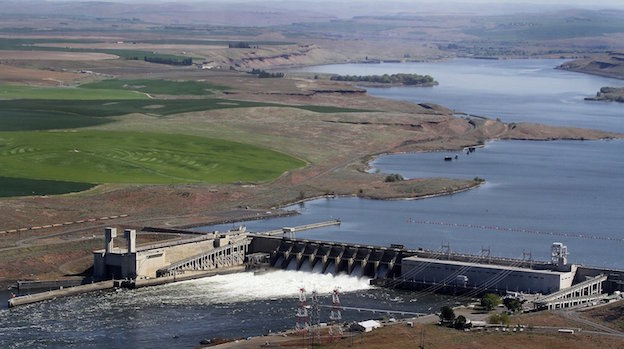forum
library
tutorial
contact

Report Estimates Lower Snake River Dams, Reservoirs
Emit Millions of Tons of Greenhouse Gases
by Alex Baumhardt
Oregon Capital Chronicle, April 9, 2024
|
the film forum library tutorial contact |

|
Report Estimates Lower Snake River Dams, Reservoirs
by Alex Baumhardt
|
Lower Snake Reservoirs release ~1.8 MMT of carbon dioxide per year.
That's equivalent to burning 2 billion pounds of coal annually,
 The possibility of removing four Snake River dams -- Ice Harbor Dam, Lower Monumental Dam, Little Goose Dam and Lower Granite Dam -- has long been a contentious one that has generally split along party lines. Shown is the Ice Harbor Lock and Dam, the first of four dams constructed as part of the Lower Snake River Project, authorized in the Rivers and Harbors Act of 1945.
The possibility of removing four Snake River dams -- Ice Harbor Dam, Lower Monumental Dam, Little Goose Dam and Lower Granite Dam -- has long been a contentious one that has generally split along party lines. Shown is the Ice Harbor Lock and Dam, the first of four dams constructed as part of the Lower Snake River Project, authorized in the Rivers and Harbors Act of 1945.
Hydroelectric dams in the Columbia River Basin lauded for providing clean energy might be emitting more greenhouse gases than previously known, according to a new report from the environmental group Tell The Dam Truth.
It comes at a time of heightened debate over the future of four Lower Snake River dams and their impact on the survival of endangered salmon and steelhead populations in the basin.
Researchers led by ecologist Mark Easter, a former research associate at Colorado State University, estimated that the Ice Harbor, Lower Monumental, Little Goose and Lower Granite dams on the lower Snake River in eastern Washington and their reservoirs release about 1.8 million metric tons of carbon dioxide per year. That's equivalent to burning 2 billion pounds of coal annually, according to the U.S. Environmental Protection Agency's emissions calculator.
Carbon dioxide and methane emissions come from decomposing surface vegetation, inundated habitat, loss of tidal wetlands and use and maintenance of turbines, locks and spillways.
Researchers from the group, which advocates for dam removal, used a data analysis and modeling tool called All-Res to estimate the lifetime emissions of the four Lower Snake River Dams. All-Res estimates include every greenhouse gas likely to have been emitted from the construction of each of the four dams during the 1960s and '70s, reservoir creation, changes to surrounding habitat and operating the hydropower systems over time. Funding to develop the modeling tool came from the nonprofit outdoor clothing company Patagonia, which also advocates for dam removal.
Conservationists and tribes have fought for decades to get the dams removed following the rapid decline of critical salmon and steelhead species after the dams were built. But farming, utilities and shipping groups have pushed back, arguing the dams are needed to transition the nation off of fossil fuels and to power Northwest industries.
In December, President Joe Biden made an agreement with Columbia Basin tribes and state governments in Oregon and Washington to invest in salmon and steelhead restoration and to consider decommissioning the Lower Snake River dams. Industry groups have criticized the agreement.
"This proposal turns its back on over 3 million electricity customers as well as the farming, transportation, navigation, and economic needs of the region," said Northwest RiverPartners, the Public Power Council and the Pacific Northwest Waterways Association, in a joint statement responding to the agreement.
Removing the four dams would require congressional approval.
The four dams produce on average enough energy to electrify about 746,000 homes in the Northwest each year, according to data from the Bonneville Power Administration. That's about 7% of all the energy generated annually by Columbia River Basin hydroelectric dams.
Beyond advocating for removing the dams, Tell The Dam Truth is also calling on the EPA to use the report as evidence that regulators should begin requiring dam operators to report emissions data. The federal agency requires facilities emitting more than 25,000 metric tons of carbon dioxide per year to report emissions.
"The Lower Snake River dams emit more than 70 times that annually," the report says.
Related Pages:
Dam Accounting: Taking Stock of Methane Emissions from Reservoirs by Tara Lohan, The Revelator, 5/25/22
Related Sites:
Evaluating greenhouse gas emissions from hydropower complexes on large rivers in Eastern Washington US Department of Energy, Pacific Northwest National Laboratory. (2013)
Inventory of Greenhouse Gas Emissions and Sinks Environmental Protection Agency, 4/15/22
learn more on topics covered in the film
see the video
read the script
learn the songs
discussion forum
